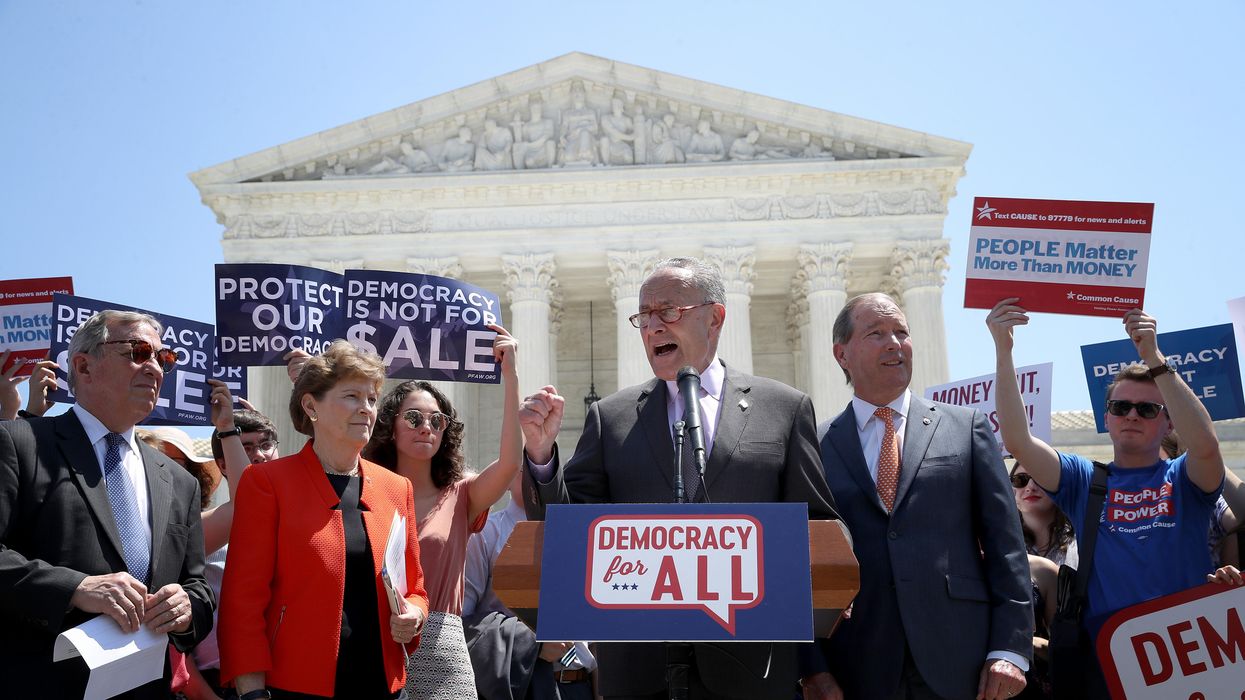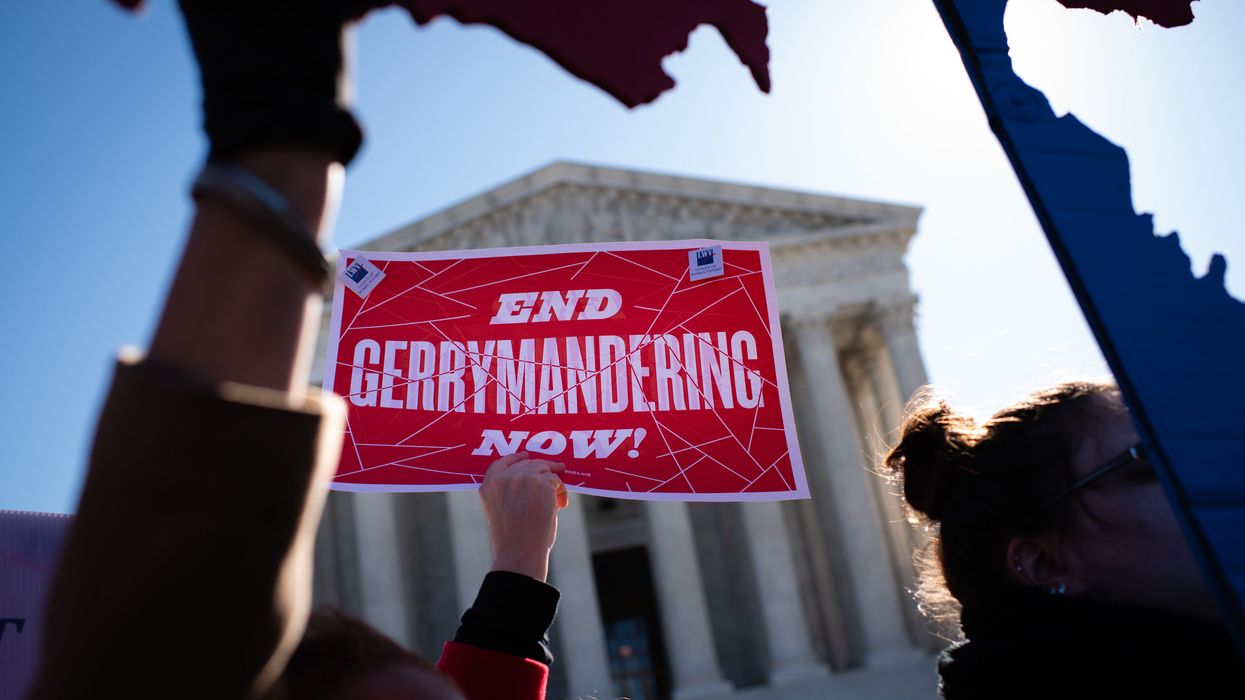As we turn the final pages on a tumultuous 2021, all this week The Fulcrum will share a year-end series of guest commentaries from a distinguished group of columnists on the current state of electoral reform and what we may expect in the upcoming year.
Clements is the president of American Promise, a nonprofit advocate for amending the Constitution to allow more federal and state regulation of money in politics.
Amid many lessons, 2021 reminded us — with intense national challenges and threats of democratic breakdown — that our nation faces systemic and structural crises. What will follow in 2022 and beyond?
It just might be much better— if we accept that the old ways are gone; if we go big enough to meet the moment; if we ground ourselves in shared values and face the common enemy with unity.
That’s our strategy at American Promise. We’re a movement of millions of Americans building a cross-partisan, citizen-driven anti-corruption campaign for the For Our Freedom Amendment, to end the pay-to-play big money system of politics.
In systemic crises, solutions of normal times become hopeless. And what seems “idealistic” in normal times becomes urgently necessary. In the words of Rep. Jamie Raskin, in the midst of the crises of 2020-21, the American Promise roadmap has moved from “impossible to inevitable.” How? With three strategies that work in times of structural crisis and transition:
- Go big. When things fall apart, big ideas find their time has come. It is riskier to play small ball in crisis than to confront the systemic, root causes head on.
- Go to the people. When trust has collapsed — in government, media, or each other — the way forward lies in decentralized, local and state-based networks, and community. When offered a chance to tackle the biggest problems themselves, where they live, Americans excel.
- Go together. Big results to build American democracy anew follow from the streams of citizen-driven reform coming together, united with shared values, to take on a common enemy of concentrated power and systemic corruption.
This is not a novel strategy. We are not the first generation to deal with whiplashing transformations in technologies, international arrangements, or social and economic assumptions that create civil unrest.
A century ago, Americans faced global war; a deadly global flu pandemic; violent division and mutual hatreds across lines of race and ethnicity; Gilded Age plutocracy, massive inequality and concentrated monopoly power; a corrupted, unelected and unresponsive Senate; and political divisions that tore the two parties apart.
What reform strategies worked? The “impossible” ones. Americans ratified four amendments to the US Constitution between 1913 and 1920. Women won the vote, we modernized the federal tax system and we forced the Senate to face the voters in elections, ending the corrupt selection process. Political innovations like citizen ballot initiatives, party primaries, campaign money rules and civil service protection broke the power of the bosses and the Gilded Age party duopoly.”
It happened again in the 1960s, with the nation fractured along lines of race, generation, gender, geography and politics, as well as the Vietnam War. Political assassination, violence and fiery riots occurred regularly. Violent, state-sponsored racism sought to deny Black Americans equal citizenship. And concentrated power, bribery, and money corruption led to the resignations of the vice president and president of the United States.
Again, Americans ratified four constitutional amendments in a decade, and drove a transformative wave of anti-corruption and campaign finance laws, environmental protection laws, civil rights laws and more.
Driving into 2022, the same strategic lessons apply.
Go big. When American Promise began five years ago, our cross-partisan amendment campaign to correct the Supreme Court’s catastrophic experiment in unlimited and unaccountable money in elections was not given much of a chance. The naysayers said, “Sure, the Democrats like campaign finance reform but you’ll never get conservatives on board.” 2021 proved them wrong.
Only weeks after the Jan. 6 insurrectionist violence in Congress, a bipartisan group of members of Congress introduced the constitutional amendment resolution in the House. Sen. Jeanne Shaheen followed in the Senate, supported by leaders from across the political spectrum in her home state of New Hampshire.
In the states, conservatives, with leadership from former state Sen. Jim Rubens of New Hampshire, joined Democrats and independents in their outrage about the billions of dollars of money, much of it from secret sources, in the 2020 races. Last month, American Promise joined ALEC in co-sponsoring a national state legislator discussion of the For Our Freedom Amendment. And Republicans are leading efforts — in collaboration with their Democratic and independent colleagues — to advance the constitutional amendment in Maine, which saw a $200 million campaign in the 2020 Senate race.
The danger of foreign money and foreign government spending to destabilize America mobilized national security leaders such as Col. Lawrence Wilkerson and Adm. Bill Owens, who have joined the American Promise National Advisory Council. American Promise Wisconsin member John Nusbaum, a Silver Star combat veteran, issued a moving call to action to his fellow veterans and to all Americans to act before it’s too late. And businesspeople across the country are saying enough is enough, and are inviting others to join the American Promise Business Network.
Go to the people. In 2021, American Promise expanded our citizen-driven, state-based campaigns to help Americans in every state ensure that every member of Congress whose vote we need by our 2024 timeline will have the support of their constituents — across the spectrum.
To date, 22 state s —six of them with citizen ballot initiatives — have called for the For Our Freedom Amendment, with Virginia coming on board in 2021. In 2022, the map is expanding and pressure is building on Congress.
Our Stand With Maine campaign helped launch the Protect Maine Elections citizen ballot initiative to prohibit foreign government money interference in elections and ensure Maine’s congressional delegation works together to pass the For Our Freedom Amendment. Building on our work with Alaskans for Better Elections we have ongoing discussions with Sen. Lisa Murkowski, Rep. Don Young, Sen. Dan Sullivan, and Alaskans across the state. We launched the Stand with Pennsylvania campaign to urge a 23rd state to call for the amendment.
Grassroots efforts are expanding in communities across America. In Wisconsin, American Promise members launched their own For Our Freedom campaign with a kick-off campaign with local veterans, civic and business groups in Green Bay. Minnesota American Promise members earned support from thousands of Minnesotans at county fairs. New Jersey American Promise members worked with Rep. Andy Kim to host a town hall meeting and encouraged the congressman to speak out on the issue in the media.
Go together. As always in America, united we will get the job done; divided we will struggle for even modest gains. The best aggregate source of what the future of a successful America looks like is a recent report from the American Academy of Arts & Sciences. “ Our Common Purpose Commission included American Promise’s amendment was among 31 specific action steps to be implemented by July 4, 2026."
We joined in the Partnership for American Democracy to accelerate all of these reforms, and I am proud to serve as a co-chair of the Election Integrity, Citizen Participation & Good Governance Pillar. We help build a stronger national reform network with our work in the National Association of Nonpartisan Reformers, the Bridge Alliance, the Committee for a Responsible Federal Budget’s FixUS network, Fix the System and more.
In dark times, we find purpose and perseverance by doing the big and hard work for the brighter days that will outlast any of us. Amid the worst of the violent 1960s, Robert F. Kennedy, who would himself be assassinated, said, “It is the shaping impulse of America that neither fate nor nature nor the irresistible tides of history, but the work of our own hands, matched to reason and principle, that will determine destiny. There is pride in that, even arrogance, but there is also experience and truth. In any event, it is the only way to live.”
Perhaps there is arrogance in Americans responding to terrible times by seeking to “shape destiny.” But it may be humility. Humility to not assume we know how the story ends. Humility to learn from history, rather than think our challenges are unique or that we know more than so many Americans before us.
All best wishes for 2022. Go big. Go to the people. Go together.



















 Despite signing a mortgage that pledged he would live in each house, Trump listed both homes as rentals. Palm Beach Daily News via Newspapers.com. Redactions by ProPublica.
Despite signing a mortgage that pledged he would live in each house, Trump listed both homes as rentals. Palm Beach Daily News via Newspapers.com. Redactions by ProPublica.
 In 1993, Trump signed a mortgage for a “Bermuda style” home in Palm Beach, pledging that it would be his principal residence. Just seven weeks later, he got another mortgage for a seven-bedroom, marble-floored neighboring property and attested that it too would be his principal residence. Obtained by ProPublica
In 1993, Trump signed a mortgage for a “Bermuda style” home in Palm Beach, pledging that it would be his principal residence. Just seven weeks later, he got another mortgage for a seven-bedroom, marble-floored neighboring property and attested that it too would be his principal residence. Obtained by ProPublica
